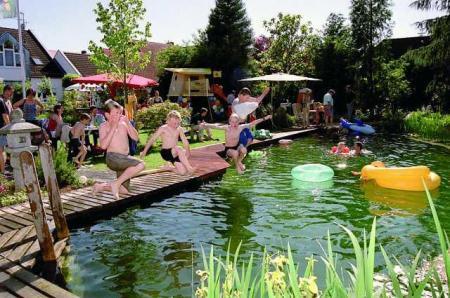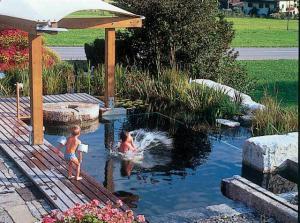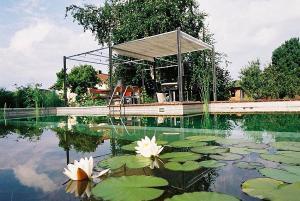No chlorine or chemicals are necessary in a natural swimming pond — the plants do all the work
By Brian Slemming
 | |
| Europe leads the way in creating natural swimming ponds and converting a typical swimming pool to a natural swimming pond where plants maintain a clean swimming environment. |
Natural swimming ponds first appeared in the mid 1980s in Germany and Austria. Since then they have become increasingly popular in Italy and Spain. Although firm numbers are difficult to obtain, the common speculation is that Europe now boasts between 25,000 and 30,000 swimming ponds. They have been constructed in private gardens for family use, in hotels and, particularly in Germany, by municipalities for public swimming. The German municipal facilities are used year-round, summer for swimming and winter for skating — a concept well-suited to the Canadian climate. In the past three years the idea has spread to the U.K. and there are now a handful of companies and architects constructing natural swimming ponds in North America.
It only looks natural
So, what is so special about natural swimming ponds? Ironically, they aren't really all that natural. The ponds are carefully designed and constructed. Although the continual cleaning of the water by the surrounding plants is a naturally occurring event, swimming ponds also use pumps and aeration to improve the performance of the plants. Nevertheless, a well-constructed swimming pond displays no evidence of the plumbing and allows its owner to enjoy all the attributes of a garden pond. It offers a variety of water plants, an opportunity for a cool dip in the summer or a brisk skate through the winter.
|
How does it work?
A natural swimming pond is one large pond divided in two by a wall that separates the larger and deeper swimming area from the more shallow vegetative area. This dividing wall extends from the pond bed to within one to two inches below the pond's surface. The water is continually circulated between the two areas by a circulating pump. Water is forced from the swimming area to the planting area where it passes through a skimmer to remove floating debris. Then the plants take over and the roots take their nutrients out of the water. Nature receives a mechanical helping-hand from the pumping system, which draws the water down into the gravel bed of the plant area. The water is then discharged back into the swimming zone. Drawing the water down through the root systems allows the plants to take up the nutrients which would otherwise create unwanted algae. The most important thing is to maintain the circulation from the swimming zone through the vegetative area and back into the swimming pond. Will Woodhouse of Woodhouse Landscape Ltd. has become quite a specialist swimming pond construction. His business is based just outside of Cambridge, England. He was one of the first in the U.K. to recognize the potential for constructing these garden features. "One of the biggest misconceptions that potential buyers have is that natural swimming ponds can be created from existing water features. They cannot. The ponds have to be dug, graded, lined and have extensive plumbing installed." Woodhouse uses a skid steer loader to dig out the initial pond which is sloped - one foot rise for every three horizontal feet will keep the sides from collapsing. The top of the excavated hole will be the area for planting. It should taper from a depth of 18 inches to two to three inches around the pond's edge. The two halves, for swimming and plants, should cover about the same surface area. This will ensure that the planted area is capable of cleaning the swimming area. Lining is the next step. "It's complicated to line," says Woodhouse. "The pond will often have unexpected shapes and bumps, then it has to go up the vertical wall which surrounds the swimming area, over the top and down to the bed of the vegetative area." There is a continuing debate about the most efficient liner. "Many people are using rubber, but I find that is more likely to sag. We use a PVC material which is harder wearing but it does require special welding expertise," Woodhouse explains. Once the liner is in place the bottom should be covered with four to five inches of gravel. The gravel bed in the planting area is mixed with a substrate to form a growing medium for the plants. It also carries the aeration system and the pipes which, when connected to the pump, pull the water down through the plant's roots, thus forcing the plants to take up the available nutrients and, in effect, clean the water before the pumping system returns the water to the swimming area.
Backyard oasis
Pool or pond?
Some images courtesy BIOTOP Natural Swimming Pool, www.swimming-teich.com |



